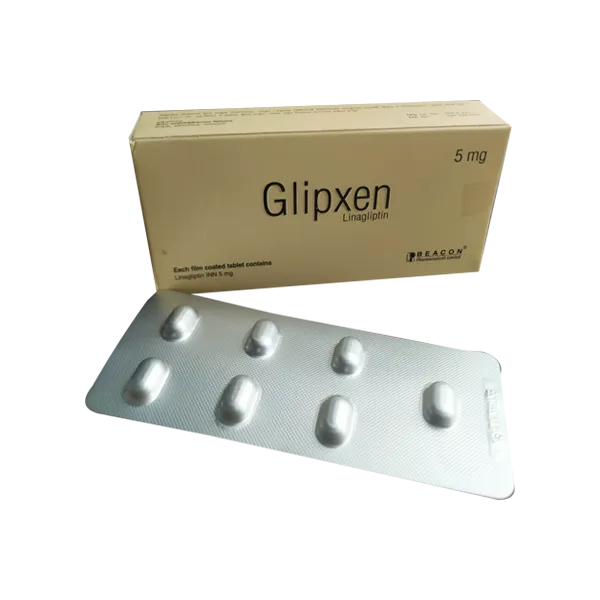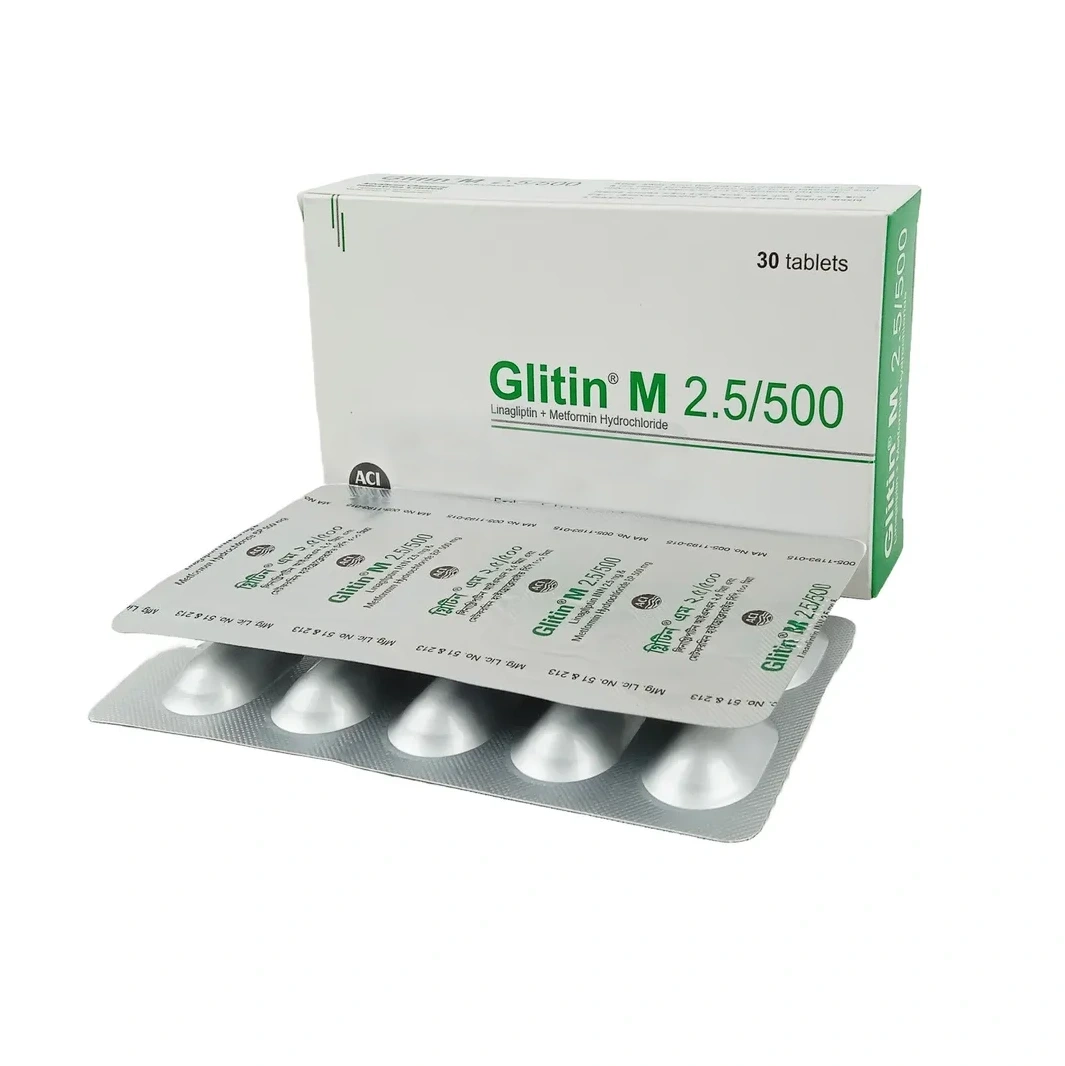Medicine Overview of Glipxen M 500 2.5mg+500mg Tablet
Glipxen M 500 is a combination of two medicines that control high blood sugar levels in people with type 2 diabetes mellitus. This helps prevent serious complications of diabetes such as kidney damage and blindness and may reduce your chance of having a heart attack or stroke.
Glipxen M 500 can be prescribed alone or together with other diabetes medications. All diabetes medicines work best when used along with a healthy diet and regular exercise. The dose you are given will depend on your condition, blood sugar levels and what other medicines you are taking. Taking this medicine with meals helps to reduce the chances of developing an upset stomach.
You should take it regularly, at the same time each day, to get the most benefit. You should not stop this medicine unless your doctor recommends it. It is controlling your blood sugar levels and helping to prevent serious complications in the future. Your lifestyle plays a big part in controlling diabetes. Therefore, it is important to stay on the diet and exercise program recommended by your doctor while taking this medicine.
The most common side effects of taking this medicine include diarrhea, nausea, vomiting, upset stomach, headache, blocked nose (nasal congestion) and sore throat. Low blood sugar level (hypoglycemia) is a possible side effect if you are also taking other diabetes medicines like insulin, glimepiride, or sulphonylurea. So you need to know how to recognize and deal with it.
This medicine is not suitable for everyone. Before taking it, you should let your doctor know if you have ever had kidney, liver or heart disease, problems with your pancreas, or if you drink a lot of alcohol. Pregnant or breastfeeding women should also consult their doctor before taking this medicine. Some other medicines MAY affect the working of this medicine, so tell your doctor about all the medicines you are taking to make sure you are safe. You should try to avoid drinking alcohol as it lowers blood sugar. Your doctor will check your kidney function and blood sugar levels before and during treatment.
- Type 2 diabetes mellitus
- Diarrhea
- Nausea
- Vomiting
- Upset stomach
- Headache
- Nasal congestion (stuffy nose)
- Sore throat
- Respiratory tract infection
- Hypoglycaemia (low blood sugar level) in combination with insulin or sulphonylurea
-
Trajenta Duo 2.5mg/500mg Tablet should be taken with food to lower the chances of having an upset stomach.
-
Take it in addition to regular exercise and a healthy diet to lower the levels of blood sugar.
-
Chances of weight gain and low blood sugar are lesser as compared to other diabetes medicines.
-
Hypoglycemia (low blood sugar level) may occur when taken along with other antidiabetic medicines, alcohol or on delaying/skipping a meal. Carry a sugar source with you for immediate relief.
-
Monitor your blood sugar level regularly while you are taking this medicine.
-
Inform your doctor about your diabetes treatment if you are due to have any surgery under a general anaesthetic.
-
Tell your doctor immediately if you experience any deep or rapid breathing, persistent nausea, vomiting or stomach pain as Trajenta Duo 2.5mg/500mg Tablet may cause a rare but serious condition called lactic acidosis, which is an excess of lactic acid in the blood.
Indicated as an adjunct to diet and exercise to improve glycemic control in adults with type 2 diabetes mellitus when treatment with both linagliptin and metformin is appropriate.
Prompt-release tablets
Initial dose (not currently taking metformin): 2.5 mg/500 mg PO BID
Initial dose (already taking metformin): Base dose on current metformin dose (eg, if taking metformin 1000 mg BID, initiate with 2.5 mg/1000 mg PO BID)
Not to exceed 2.5 mg/1,000 mg BID
Extended-release tablets
Individualize dose on the basis of both effectiveness and tolerability, while not exceeding the maximum recommended total daily dose of linagliptin/metformin 5 mg/2000 mg
Initial dose (not currently taking metformin): 5 mg/1000 mg PO qDay
Initial dose (already taking metformin): 5 mg of linagliptin total daily dose and a similar total daily dose of metformin qDay
Switch from prompt-release linagliptin/metformin: 5 mg of linagliptin total daily dose and a similar total daily dose of metformin qDay
Hepatic impairment: Not recommended because of increased risk of lactic acidosis
<18 years: Safety and efficacy not established
Renal impairment
Obtain eGFR before starting metformin
eGFR <30 mL/min/1.73 m²: Contraindicated
eGFR 30-45 mL/min/1.73 m²: Not recommended to initiate treatment
Monitor eGFR at least annually or more often for those at risk for renal impairment (eg, elderly)
If eGFR falls below 45mL/min/1.73 m² while taking metformin, risks and benefits of continuing therapy should be evaluated
If eGFR falls below 30 mL/min/1.73 m²: while taking metformin, discontinue the drug
Hypersensitivity. Type 1 diabetes, diabetic ketoacidosis or pre-coma, renal failure or dysfunction (CrCl <60 mL/min), hepatic insufficiency, acute alcohol intoxication, alcoholism. Acute conditions w/ the potential to alter renal function eg dehydration, severe infection, shock, IV administration of iodinated contrast agents. Acute or chronic diseases which may cause tissue hypoxia eg cardiac or resp failure, recent MI. Lactation.
Linagliptin: Dipeptidyl peptidase 4 (DPP-4) inhibitor; increases and prolongs incretin hormone activity from glucagon-like peptide-1 (GLP-1) and glucose-dependent insulinotropic polypeptide (GIP) which are inactivated by the DPP-4 enzyme; incretins increase insulin release and reduce glucagon secretion
Metformin: Decreases hepatic glucose production; decreases GI intestinal glucose absorption; increases target cell insulin sensitivity; lowers both basal and postprandial plasma glucose and unlike sulfonylureas, does not typically produce hypoglycemia or hyperinsulinemia
Monitor for pancreatitis, hypoglycaemia, lactic acidosis, renal impairment. Intravascular administration of iodinated contrast agents. Co-administration of insulin. Discontinue treatment 48 hr before elective surgery w/ general, spinal or peridural anaesth. Evaluate serum electrolytes & ketones, blood glucose & if indicated, blood pH, lactate, pyruvate & metformin levels in patients w/ previously well controlled type 2 diabetes on Trajenta Duo who develops laboratory abnormalities or clinical illness.
Pregnancy. Childn & adolescents <18 yr. Elderly.
Lactation: Metformin excreted in human milk in low concentrations; unknown if linagliptin excreted in human milk
No studies in lactating animals have been conducted with the combined components; because the potential for hypoglycemia in nursing infants may exist, a decision should be made whether to discontinue nursing or to discontinue the drug, taking into account the importance of the drug to the mother
>10%
Hypoglycemia (with sulfonylurea) (22.9%)
1-10%
Nasopharyngitis (6.3%),Diarrhea (6.3%),Hypoglycemia (without sulfonylurea) (1.4%)
Frequency Not Defined
Hypersensitivity (eg, urticaria, angioedema, or bronchial hyperactivity),Cough,Decreased appetite,Nausea,Vomiting,Pruritus,Pancreatitis
Linagliptin: Inhibits P-glycoprotein-mediated transport of digoxin (w/ low potency). Increased AUC & Cmax w/ ritonavir. Decreased steady-state AUC & Cmax, & DPP-4 inhibition at trough w/ rifampicin. Weakly inhibits CYP3A4-mediated metabolism (eg simvastatin).
Metformin: Increased risk of lactic acidosis in acute alcohol intoxication. Competition on common renal tubular transport systems w/ cationic agents eliminated by renal tubular secretion (eg cimetidine). Risk of renal failure & lactic acidosis w/ intravascular administration of iodinated contrast agents.


































